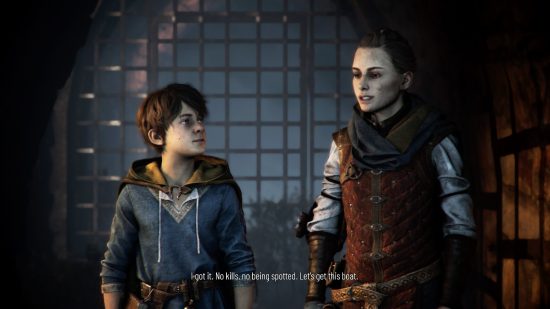[ad_1]
Our Verdict
A Plague Tale Requiem is much the same as Innocence in terms of gameplay, but its character development and blood-soaked universe make it an absolute pleasure to play.
As soon as I saw its stomach-turning announcement trailer, I knew I wanted to write our A Plague Tale Requiem review. As a lover of all things dark and macabre, and a historian with a bizarre fascination with the Black Plague, the rat game‘s predecessor Innocence was a dream – nightmare? – come true in the best possible way. It set high standards for any possible sequel, but boy has Asobo Studio lived up to those standards with Requiem.
That’s a relief, because I didn’t feel so confident after my hands-on preview at Gamescom. I walked away from that experience feeling slightly deflated (although my interview with lead level designer Kevin Pinson remains one of my favourites from the event). Why? The snippet of gameplay I tested just felt like more of the same. More stealth, more projectiles to hurl at unsuspecting guards, and a lot more rats. So what’s changed?
It isn’t the gameplay, as Requiem is still very much the same as Innocence in this regard. You’re still encouraged to use stealth, you don’t really get a lot of opportunities to get up close and personal with foes (unless you seek them out, of course), and you’re still dodging rodents at every turn. I wondered how Asobo could innovate on this formula coming into Requiem and, the answer is that it hasn’t, beyond adding a few new throwables.
The real difference is with the characters. ‘Innocence’ was so named because protagonists Amicia and Hugo were, literally, innocent: they were an ordinary girl and boy whose lives were plunged into tragedy. They were children in Innocence, but they are not in Requiem.
Amicia clearly suffers from multiple forms of PTSD, as we see her hands continually shaking throughout the story. When asked about this she aggressively bats off concerns, but this inner trauma affects everything she does. A sequence in the third chapter sees Amicia confronts a troop of guards while looking for a specific herb to help Hugo. As her companion Lucas cowers in the corner, she experiences a short-term psychotic break, screaming at her opponents that she “is the little girl that’s killing [them]” whilst slingshotting rocks and popping heads. The Amicia of Innocence is gone, replaced by a young woman whose thirst for vengeance has shattered her.
Requiem may play the same as Innocence, but this version of Amicia is battle-hardened and out for blood; a stark contrast to her former self. This adds a sense of intensity to slaughtering hordes of soldiers. Where you wanted to melt into the shadows and pick off enemies from afar in the first game, Amicia’s rage in Requiem is infectious, tempting you to get up close and personal with guards and gut them, or command the rats to tear them asunder. The sickly sweet satisfaction Amicia feels when a guard crumples to his knees is exhilarating; her hatred is your hatred, and justice tastes good. This adds a gritty new dynamic to the combat, which is welcome, as I admittedly found my interest waning a little in Innocence despite the game’s setting and story.
There’s no shortage of storytelling in Requiem either, though. From the onset there’s a sense that something just isn’t right. The game opens in a seemingly idyllic countryside setting, where Lucas, Amicia, and Hugo play knights in shining armour together amid the derelict runes of a once-proud castle. Things quickly take a turn for the worse, however, forcing the family away to the regal citadel simply known as the ‘red city’ which becomes their new home. In this foreign world the streets are chock-full of people bustling around a traditional marketplace, seemingly oblivious to the horrors that lie just beyond their gates. It’s immediately suspicious and disturbing.
As you unearth the area’s secrets you realise that this façade of civility is just that, and that Hugo’s presence spells ruin for this supposed haven of wonder and excitement. I’ll share no further specifics for fear of spoilers, but the story that ensues is masterfully crafted and rich in lore.
It also has a soundtrack that has made me cry once or twice, and superlative sound design that brings Asobo’s 14th-century France to life. Torches spit and flicker around you, while the ground rumbles ominously ahead of a rat attack. When the plague-ridden vermin finally burst forth, the screeching and scratching is almost overwhelming – you struggle to hear anything else when playing with headphones – making your skin crawl and your stomach turn. At one point, Amicia and Lucas land right in the middle of a butcher’s landfill site, where entrails and muddied bodily fluids slorp around like quicksand, sucking at their legs and genuinely making me taste my lunch again. The storytelling itself is strong, but it’s nothing without ambience, and Asobo has perfected this across the Plague Tale series. It’s immersive, it’s creepy, and in some cases downright disgusting, and I love every moment of it.
The only thing that clouds Requiem’s masterfully crafted world are a few visual and gameplay bugs. For example: a pop-up prompt to craft the Extinguis (effectively a smoke bomb that also smothers flames) refused to go away for a whole chapter, interrupting menu and gameplay navigation. Another bug prevented me from finishing a puzzle in act two, which Asobo has acknowledged and is looking to iron out before the game goes live. A few smaller bugs will likely remain, as well as a slew of bizarre translational errors, but we’re a long way short of Cyberpunk 2077 territory.
Despite these little errors, A Plague Tale Requiem has inched ahead of Metal: Hellsinger as my favourite game of the year. In fact, I think it’s even better than Innocence. I’ve stayed up until 2am playing this game, and I’m one of the few gamers who has never done that before (yes, seriously; I need my beauty sleep.)
Other critics may say it’s too similar, but the character development, plotline, and sheer abundance of rats make this game feel more fleshed out (pardon the pun) than its predecessor. There’s a twist at every turn, a tragedy for every triumph, and a real sense that our protagonists are not just virtual beings, but two children with fears, thoughts, and feelings.
A requiem is ‘a mass for the dead,’ and whether this marks the end of Amicia and Hugo’s journey remains unclear. Either way, though, Plague Tale Requiem is an RPG experience that you’ll want to sink your teeth into.
[ad_1]






